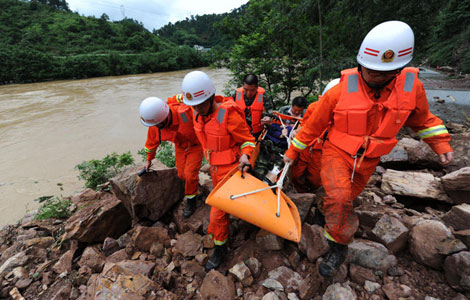
The Ministry of Health, Labor and Welfare is poised to standardize the formats of electronic dental records for use in body identification in case of major disasters, it has been learned.
The move comes on the heels of the Great East Japan Earthquake, when experts had a hard time identifying the bodies as many of their dental records had been swept away by the tsunami and the remaining records were found in different formats.
In fiscal 2013, the ministry is embarking on a verification project for standardizing the currently unintegrated dental data formats. It is expected that once those formats are standardized and records are compiled into databases in the future, they will be utilized in cases other than disasters as well.
In the March 2011 quake disaster, dental records played a critical part in identifying the bodies of 1,240 people who died in the natural calamity -- well surpassing the 163 who were identified through DNA testing, according to a National Police Agency survey as of April 10 this year.
While human teeth are more likely to remain intact even after bodies are damaged, it was difficult in the wake of the 2011 disaster to identify bodies by the dental treatment records of the missing. The Miyagi Prefectural Police force introduced software that is capable of collating such dental information with the cooperation of Tohoku University some two months after the quake and tsunami and strived to collect electronic and paper dental records on those missing kept in computer storage devices at dentists. However, because the formats and contents of those records varied, experts had to re-enter the data in integrated formats.
For a feared massive earthquake centering in the Nankai Trough off central to western Japan, the government puts the casualties at some 320,000 in a worst-case scenario. If no measures are taken, procedures to identify bodies are expected to be enormous tasks.
The ministry is therefore setting up a review panel as early as June to discuss how to standardize information formats for body identification. The ministry has allocated 21 million yen in the fiscal 2013 budget for launching the verification project, in which standardized e-records will be introduced at some dentists on an experimental basis by the end of this fiscal year.
Tadahiro Yanagawa, a director at the Japan Dental Association, who has insisted on the necessity to standardize such records since before the 2011 disaster, lauded the ministry's move. "In the case of a Nankai Trough quake, body identification would be difficult unless we have a system to swiftly collect dental information. The verification project will provide a good opportunity for establishing a system including database creation in the future."
Meanwhile, Masao Horibe, professor emeritus at Hitotsubashi University who is specializing in personal information protection, pointed out that "it is necessary to clarify the objective of identity confirmation and obtain the person's consent to provide their personal information."
The health ministry is currently not planning to consider whether to create databases using those electronic dental records.
Friday 17 May 2013
http://mainichi.jp/english/english/newsselect/news/20130517p2a00m0na007000c.html
continue reading










